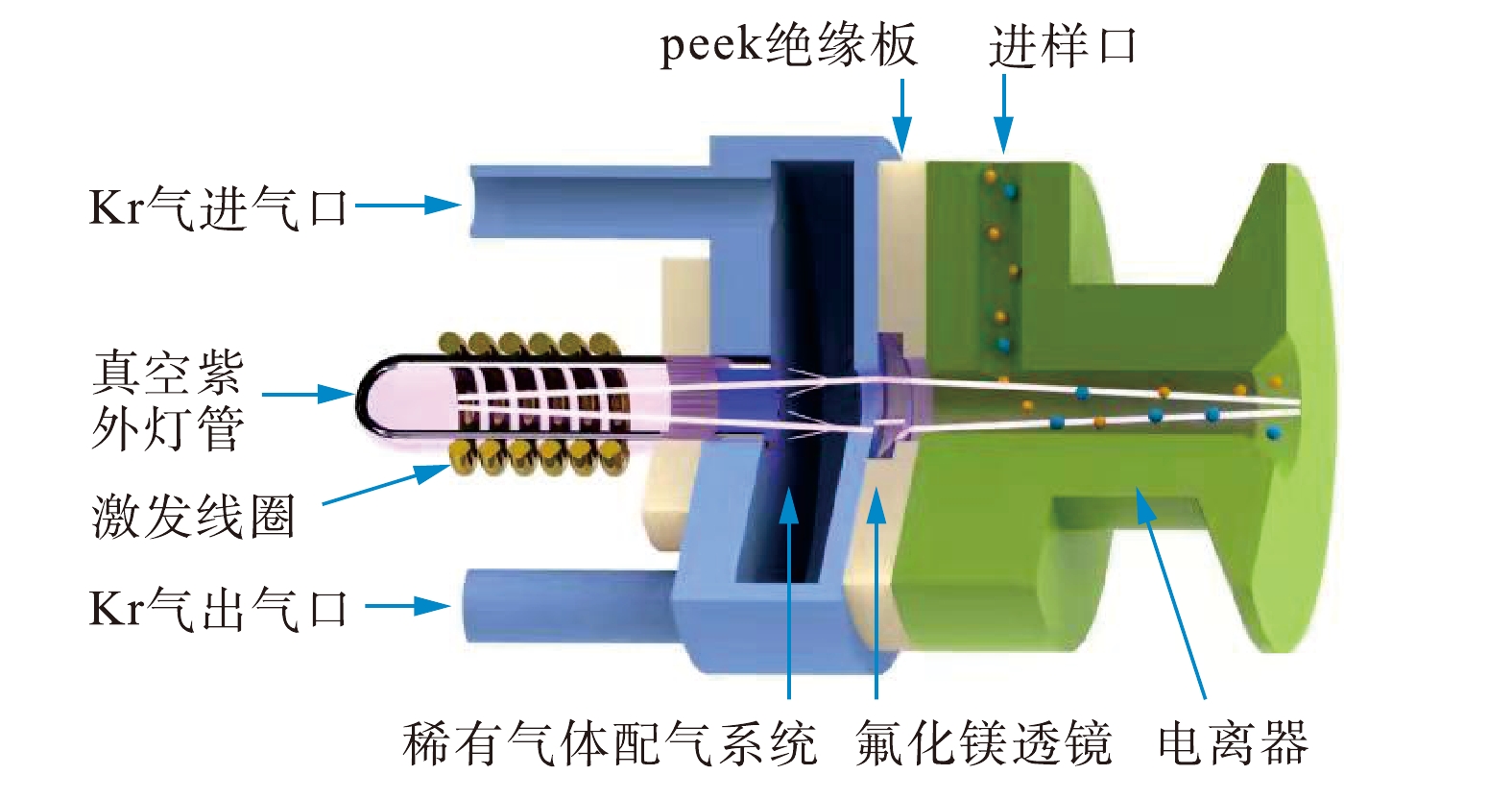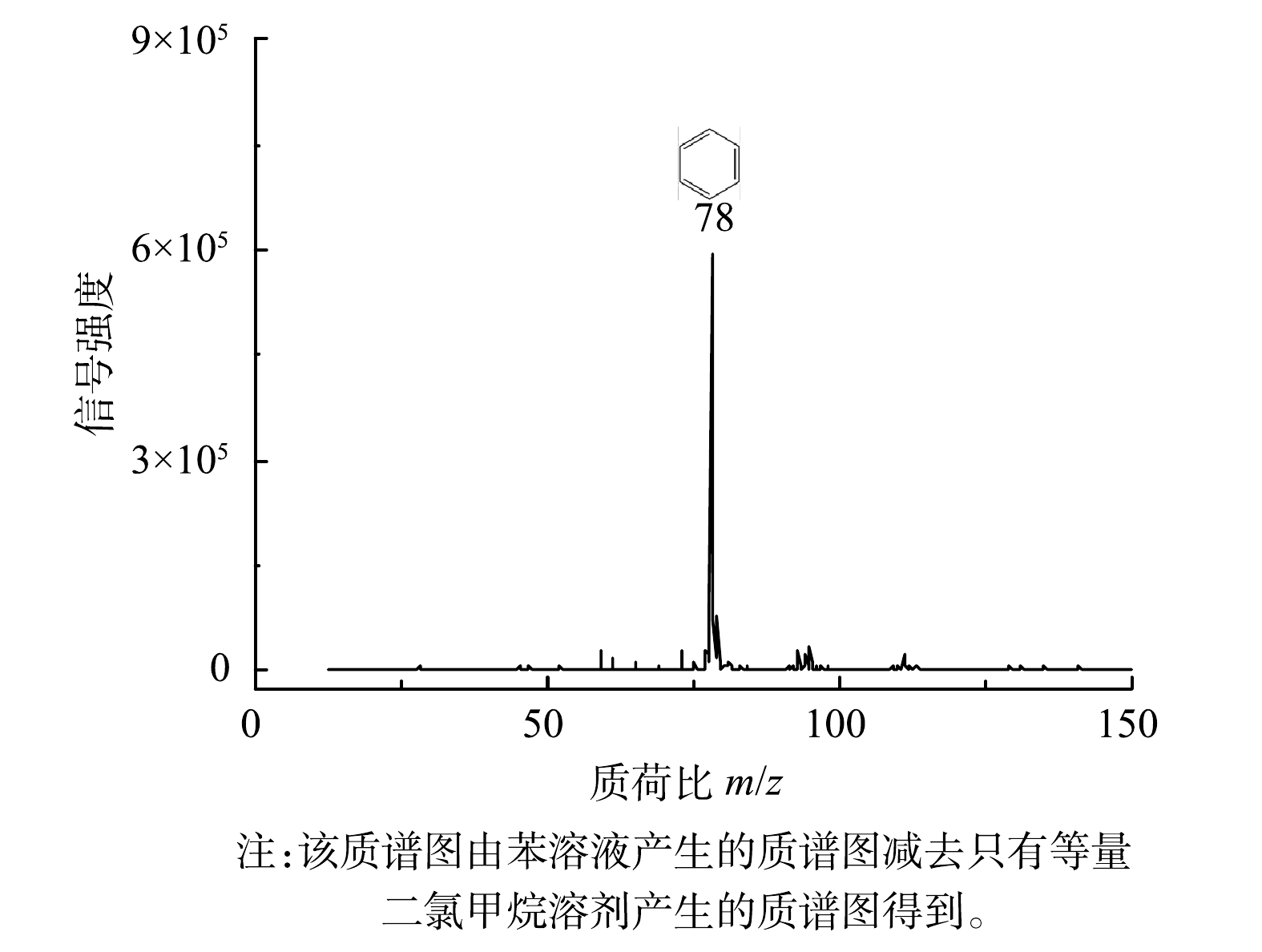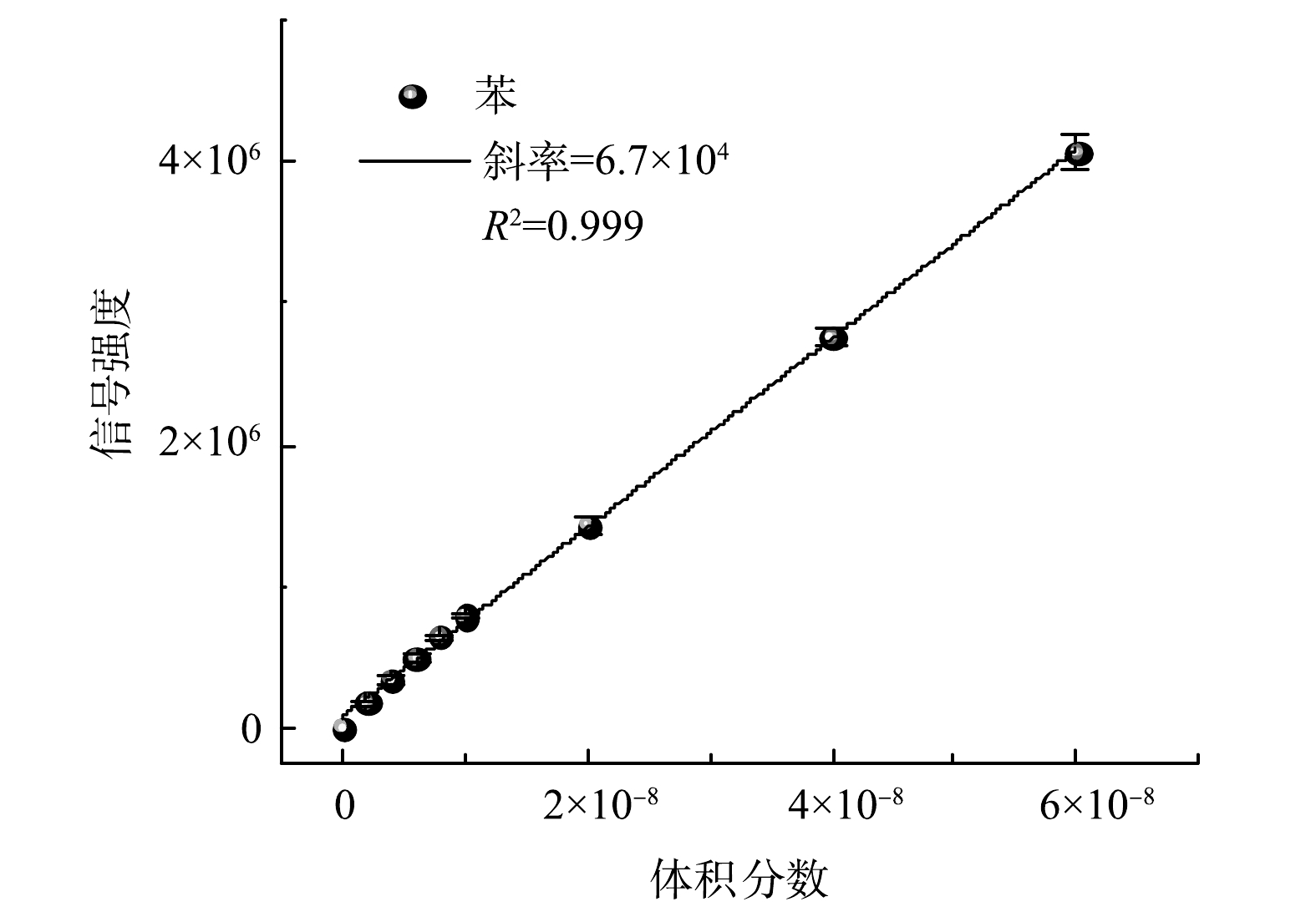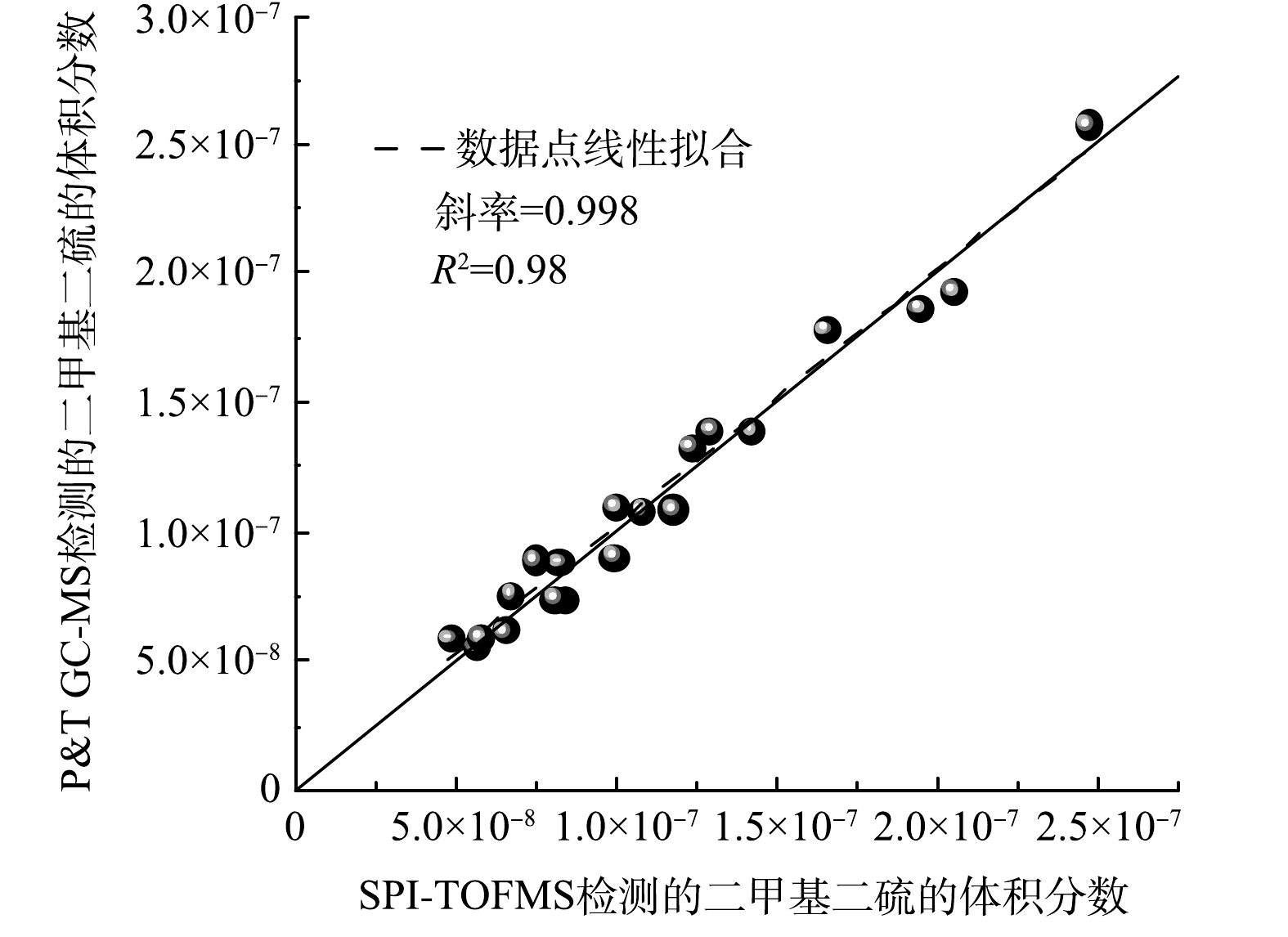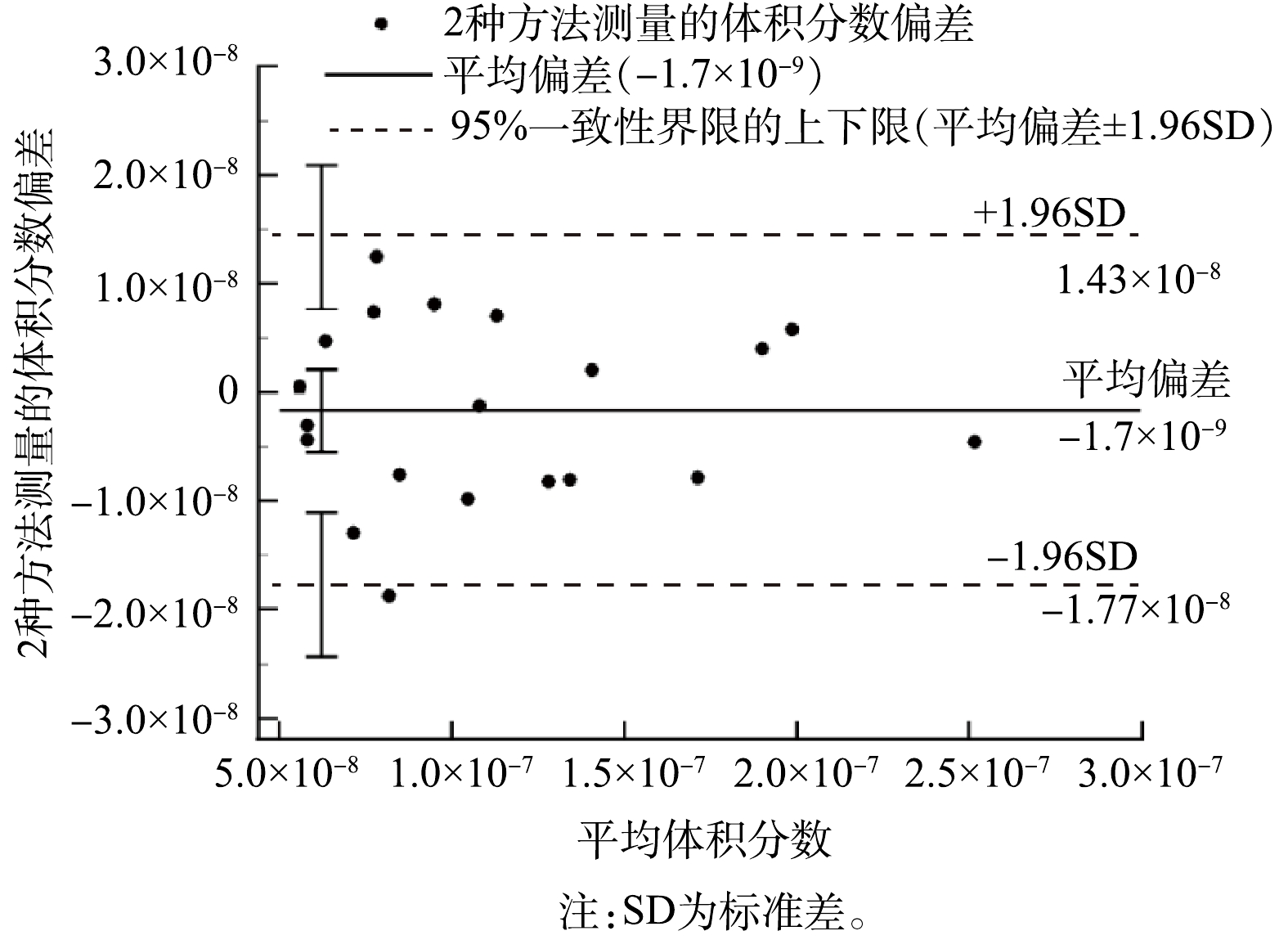-
挥发性有机物(VOCs)的高灵敏在线监测在大气污染过程监测与溯源、化工园区VOCs溯源与突发事件应急监测以及痕量毒品和炸药的安检等多个领域均起到重要作用[1-2]。尤其在环境领域,VOCs不仅作为室内室外污染中的一次污染物,危害人体健康,还可在大气光氧化条件下产生灰霾和臭氧等二次污染[3-4]。另外,一些VOCs具有极低的嗅阈值,较低的空气浓度即可对人体嗅觉感官造成强烈刺激,引发臭味污染问题。在我国,恶臭投诉事件相当频繁,仅次于噪声的投诉事件,排在第二位,且呈逐年递增的趋势[5-7]。因此,发展VOCs高灵敏在线监测技术对大气污染防控、减少环境污染事件对社会的负面影响具有重要意义。
近年来,质谱技术的飞速发展为VOCs的高灵敏在线监测提供了一种有效的技术手段。目前,用于VOCs直接、在线监测的VOC质谱仪主要包括基于电子电离(EI)、化学电离(CI)和单光子电离(SPI)技术的单质谱[8-14]。其中,发展较成熟的高灵敏VOC质谱为质子转移质谱(PTR-MS),属于化学电离质谱的一种。该仪器可以检测体积分数为10−12量级的VOCs[15-19],已被很多国际一流团队用于实验室及外场VOCs的直接在线测量。与CI相比,SPI属于一种特别的软电离技术[20],它最大的特点是电离方式简单:任何电离能(IE)低于光子能量的原子或分子都会在真空紫外(VUV)灯的辐照下直接电离,生成一个带正电荷的待测物阳离子。SPI具有分子离子产率高、碎片少、质谱简洁、线性动态范围较宽、对极性和非极性有机物都适用等独特优势,非常适合实际VOCs混合样品的直接、在线监测[21]。
在SPI-MS中,VUV光源的产生方式和光子通量对仪器的适用性和检测灵敏度至关重要[21]。大型VUV光源(如同步辐射光源[22-25]和基于激光器的光源[26-27])可以实现高光束密度,但是由于其成本高、体积大和操作复杂等原因,只能用于实验室研究。为了满足常规监测仪器的需要,SPI相关的监测仪器通常使用体积小、携带方便的VUV灯作为SPI光源。常用的VUV灯主要包括直流放电灯和射频放电灯,分别使用直流或射频放电激发低压Kr气产生10 eV的VUV光[28]。然而,目前使用较广泛的商用VUV灯的光子通量约为1011 s−1[29-30],导致SPI离子源的电离效率以及相应的SPI-MS的检测灵敏度较低,成为阻碍SPI-MS发展为高灵敏商用VOC质谱仪的主要因素之一。
为了提高SPI-MS的检测性能,众多研究者在发展新型光电离源方面开展了大量工作。已有研究[31-34]表明,研制新型VUV灯,提高光子通量,是提升SPI-MS检测性能的一种途径。MUHIBERGER等[32-35]开发了一系列电子束激发稀有气体灯,光子通量达到了1013~1016 s−1,将电子束激发稀有气体灯与小型飞行时间质谱(TOFMS)或四级杆质谱(QMS)联用,能够在线检测体积分数为10−9以上的气态有机物。另外一种提升SPI-MS检测灵敏度的途径是增加SPI离子源内的压力[36-39],由此衍生出的技术包括低压光电离(LPPI)和高压光电离(HPPI)技术,相应的电离区压力为几十~几千Pa。SUN等[40]和LI等[41]使用光子通量为1014 s−1的射频VUV灯研制了1台低气压SPI-TOFMS,离子源内气压为500~1 000 Pa,在检测体积分数为10−9的气相苯系物时,10 s内的信号强度可达到5 000,有效提升了SPI-MS的检测灵敏度。然而,该仪器是概念型样机,体积较大,难以用于外场实地VOCs的在线监测。
本研究在已有研究的基础上,基于高通量射频VUV灯、低气压光电离离子源和飞行时间质谱技术,研制出1台紧凑型高灵敏SPI-TOFMS,用苯标准气体对SPI-TOFMS的检测灵敏度、检测限、检测精确度和准确度进行性能测试,考察SPI-TOFMS在农药污染场地异味气体检测中的应用效果,验证SPI-TOFMS在实地VOCs混合物快速检测上的优势及定量能力,以期为环境科学与工程领域涉及的VOCs高灵敏在线监测提供技术支撑。
-
高灵敏SPI-TOFMS装置结构如图1所示。该仪器主要由真空系统、进样系统、VUV光电离源、离子传输系统、垂直引入反射式飞行时间质量分析器和数据采集系统组成。整台仪器设计紧凑,主体部分长度为456 mm,宽度为380 mm。样品分子在VUV灯照射下发生单光子电离产生离子,被离子源的加速电压加速后,通过离子传输系统进入垂直引入反射式飞行时间质量分析器,通过无场飞行区后,到达微通道板离子检测器,最终被数据采集系统收集并进行质谱分析。离子反射区和离子引出区的电极设计和工作电压如图2所示。
-
真空系统分为束源室、差分室和TOF室三级差分系统,分别由3台分子泵维持真空,另外使用1台干泵为3台分子泵提供前级真空。1台干泵为ECODRY 40 plus干式真空泵(德国Leybold公司),抽速为40 m3·h−1;分子泵为1台Agilent TV 301 Navigator涡轮分子泵(美国Agilent公司,对N2抽速为280 L·s−1)和2台Pfeiffer HiPace 300涡轮分子泵(德国Pfeiffer公司,对N2抽速为260 L·s−1);真空规为1个Pfeiffer TPR270皮拉尼规(德国Pfeiffer公司)和2个Pfeiffer PKR361全量程真空规(德国Pfeiffer公司)。真空系统能够使仪器的真空度在进样前保持在2×10−5 Pa以下,进样时,束源室、差分室和TOF室的动态真空度分别约为1、0.3和1×10−3 Pa。
-
进样接口由直径为0.635 cm的不锈钢管将质谱仪与外界空气相连接,通过仪器负压将气相样品被动吸入仪器内。进样时,使用针阀控制进样流量,检测时流量通常为3.3 cm3·s−1。使用气体标定腔配制一定体积分数的样品气体。气体标定腔是一个体积为60 L的开口不锈钢圆筒,上端与一个特氟龙(Teflon)袋密封连接,以保证气体标定腔内维持1个大气压(101 325 Pa)。实验前,使用高纯氮将气体标定腔反复充放气来清洗气体标定腔,将其充气到一定体积。配制样品气体时,向气体标定腔内注射一定浓度的样品溶液,待其挥发完全,即得到一定浓度的气相样品。气体标定腔底部装有磁力搅拌风扇,使气相样品混合均匀;外部覆有加热衣,可调节气体标定腔的温度,便于样品溶液挥发。实验过程中的温度控制在65 ℃。
-
真空紫外单光子电离源由VUV灯和电离器组成,结构示意图如图3所示。VUV灯主要由放电石英灯管、线圈、Kr气配气系统、氟化镁窗片和射频电源组成。射频电源工作频率为13.56 MHz,正常工作功率为60 W。射频电源通过线圈激发惰性气体(5%的Kr气,He气作为缓冲气体)产生真空紫外光。石英灯管内Kr气的压力为250 Pa。真空紫外光穿过氟化镁窗片进入电离器中,光子通量达到6.6×1014 s−1·cm−2,光子能量为10.0 eV(80%)和10.6 eV(20%)。样品分析物通过进样系统进入到电离器中,此时离子源的工作压力为1 300 Pa,经VUV光照射发生单光子电离,产生的离子随后进入离子传输系统。
-
离子传输系统由1组与飞行时间质量分析器垂直装配的离子透镜组成。这种垂直装配的组成结构可以使离子传输系统与飞行时间质量分析器在不设置离子偏转装置的情况下,只需使用合适的加速电压匹配离子的入射动能即可使离子反射后落在检测区内,实现离子检测。离子透镜组由8片中空圆极板组成。给前后4片极板与中间4片极板施加不同的迁移电压,形成聚焦电场。聚焦电场将电离器输送来的离子聚焦为离子束,通过狭缝传输至飞行时间质量分析器。
-
飞行时间质量分析器为垂直加速V型反射式结构,包括离子引出区、离子加速区、无场漂移区、离子反射区和微通道板检测器5个部分,离子飞行距离为220 mm。离子通过狭缝进入质量分析器后,在脉冲引出场的作用下,进入离子加速区加速,漂移过后,进入离子反射区。离子经过减速、反转和加速3个阶段后,漂移飞行进入离子检测器。当离子撞击到微通道板后,产生的电流信号由数据采集系统采集记录。质量分析器在 m/z=182处的质量分辨率(m/Δm)约为500。
-
数据采集系统主要由脉冲/延时发生器、放大器、数据采集卡和计算机组成。微通道板检测器检测到的离子信号经过放大器放大20倍后,再用多通道数据采集卡(P7888,德国Fast ComTech公司)进行采集,每次采集时间为10 s。每次实验都会测量3次来保证数据的可重复性。
-
气态苯是一种常见的室内室外污染物,具有较大的光电离截面,常被用来表征光电离质谱的检测灵敏度,因此,本研究使用苯标准蒸汽测试仪器的灵敏度及检出限。用二氯甲烷将纯苯稀释416倍,制备成苯标准溶液。用微量进样器取1 μL苯溶液,注入到气体标定腔内,待挥发完全,经风扇混匀后,得到体积分数为10×10−9的气相苯。在灵敏度实验中,通过注入的次数来控制气体标定腔内苯的气体体积分数。
-
光通量是通过固定在距离灯出口73 mm处镀金的铜板测量的。将一个导流针放在金板的正上方,处于金板和灯之间并靠近金板的位置。当给导流针施加一个正直流电压时,导流针可以引导光电子离开镀金铜板表面,通过连接镀金铜板的皮安表(Keithley Instruments公司,6485型)可以测出此时产生的光电流。光电流转化成光子通量的计算方法如式(1)所示。
式中:Ф为单位面积内的光子通量,s−1·cm−2;Q为基本电荷,其数值为1.6×10−19 C;ε为光电子产率,数值为0.063;S为电离区入口的横截面积,cm2。
-
农药行业是异味污染的主要贡献者,特别是在废弃农药污染场地的修复再利用过程中,非常容易引起异味投诉。在本研究中,使用125 L的静态通量箱收集某废弃农药污染场地地面释放的异味气体0.5 h后,使用0.5 L的特氟龙袋采样,采用SPI-TOFMS对气袋内的VOCs进行直接检测。同时,将相同的静态通量箱内的气体用苏玛罐采样后,使用P&T GC-MS按照USEPA TO15-1999标准方法进行检测,将2种分析方法的结果进行对比分析[42]。
-
图4显示的是体积分数为10×10−9的苯在氮气中的SPI-TOFMS质谱图。由于配制苯标准溶液使用的溶剂是二氯甲烷,而当二氯甲烷存在时,SPI离子源内会产生大量的水合质子(H3O+)及其团簇离子((H2O)2H+、(H2O)3H+和(H2O)4H+),因此,为了得到简明的待测物质谱图,往往需要用待测物/二氯甲烷的质谱图减去等量纯二氯甲烷的质谱图(质谱背景)。由图4可以看出,减去二氯甲烷引起的质谱背景后,苯的SPI质谱图中只有m/z=78的母离子峰为主要特征峰。
-
使用气体标定腔配制不同体积分数的苯,使用SPI-TOFMS获得不同体积分数下苯的信号强度。对分子离子信号强度(m/z=78)与气相苯的体积分数进行线性拟合,得到苯的灵敏度校正曲线。如图5所示,在体积分数为2×10−9~60×10−9时,线性拟合曲线的线性较好(R2=0.999)。由线性拟合的斜率可计算得到SPI-TOFMS对苯的检测灵敏度:体积分数为10−12的苯对应的信号强度为67±0.70(10 s检测时间)。目前已有研究[43]报道的灵敏度最高的PTR-MS对苯的检测灵敏度:体积分数为10−12的苯对应的信号强度为7左右(1 s检测时间)。因此,本文报道的紧凑型高灵敏SPI-TOFMS对苯的检测灵敏度与灵敏度最高的PTR-MS相当,且明显优于同类型SPI-MS。SPI-TOFMS对苯的检测限(LOD)的计算方法见式(2)。
式中:L为检测限;σ为质谱信号背景噪声的标准偏差,其数值为2.2;s为检测灵敏度。
在10 s采集时间内,仪器对苯的检测限(以体积分数计)为(0.09±0.00)×10−12。值得注意的是,SPI-TOFMS具有非常高的检测灵敏度,因此,在检测高浓度有机物时,因到达离子检测器的离子量过大,逐渐超出离子检测器对信号的线性响应范围,则信号强度与待测物浓度之间的线性度会有所下降(如本仪器对体积分数超过60×10−9的苯的线性度有所下降)。因此,该质谱技术适宜对环境空气中的低浓度痕量有机污染物进行在线监测。如果监测高浓度有机污染物,则需要预先对气体样品进行稀释处理,或者改变质谱内离子的迁移电压,人为降低仪器的检测灵敏度。
-
在本研究中,准确度表示在3次平行实验中,苯的3次测量值与其平均值的比值。为了方便讨论,本研究选取3个比值中与100%差值最大的一个数值作为准确度;精确度表示苯的3次测量值的标准偏差。如表1所示,由SPI-TOFMS对体积分数为2×10−9~60×10−9的苯的检测结果可以得出,在此体积分数范围内,SPI-TOFMS对苯的检测准确度为95%~109%;精确度的标准偏差总体上小于8%。由此可知,SPI-TOFMS在VOCs的直接在线检测方面具有良好的可靠性。
-
某农药污染场地释放的异味气体样品的SPI-TOFMS质谱图如图6所示,P&T GC-MS检测得到的化学组分如表2所示。可以看出,除了相对分子质量为26的乙炔,P&T GC-MS检测到的所有物质的相对分子质量(图6中以星号标记的质量峰)都能在SPI-TOFMS质谱图中看到。另外,除了P&T GC-MS检测到的这些质量峰外,在SPI-TOFMS质谱图中,还能观察到大量其他质量峰(除星号标记以外的质量峰),这些质量峰主要为未被P&T GC-MS检测到的物质。
结合农药企业的原料和产品信息,将SPI-TOFMS质谱(图6)中观察到的m/z为48、62、76、94和126的质量峰归为挥发性有机硫化合物。这些有机硫化合物分别为甲硫醇(m/z=48)、二甲基硫(m/z=62)、乙硫醇(m/z=62)、甲基乙基硫(m/z=76)、二甲基二硫(m/z=94)和二甲基三硫(m/z=126)。在这些可能的有机硫化合物中,只有二甲基二硫在P&T GC-MS中具有100%的检出率,二甲基二硫也是该农药污染地块释放的主要有机污染物。此外,还有一些含氮的异味物质没有被P&T GC-MS检测到。根据农药企业的原料和产品信息,将m/z为69、79、87、93、108和123的质谱峰归为吡咯烷、吡啶、乙基丙胺、苯胺、邻苯二胺和硝基苯。
为了评价SPI-TOFMS的定量能力,分别用SPI-TOFMS和P&T GC-MS测定了20组体积分数为56×10−9~246×10−9的二甲基二硫样品。如图7所示,2种检测方法得到的二甲基二硫的体积分数呈良好的线性关系,斜率为0.998,R2=0.98。2种方法的一致性可通过Bland-Altman分析方法来评估[44-45]。如图8所示,SPI-TOFMS和P&T GC-MS分别测定的二甲基二硫体积分数在此范围内有较小的负偏差(−1.7×10−9),标准差(SD)为8.16×10−9,95%的一致性界限(平均偏差±1.96SD)为−17.7×10−9~14.3×10−9。这说明SPI-TOFMS与P&T GC-MS标准方法的定量结果具有较好的一致性,但相比之下,SPI-TOFMS的分析时间要短得多。这些结果表明,高灵敏SPI-TOFMS有助于快速、全面地筛查复杂的异味气体的化学组成和浓度范围,从而对国标方法难以检测的未知物质做进一步分析,最终获得异味气体所有组分信息。
-
1) 本研究研制的紧凑型高灵敏SPI-TOFMS可作为车载式仪器,直接、在线监测外场环境空气中的痕量VOCs。在10 s的检测时间内,该仪器对苯的检测限(以体积分数计)为0.09×10−12。
2) SPI-TOFMS对不同体积分数(2×10−9~60×10−9)的苯的检测准确度为95%~109%,检测精确度的标准偏差总体小于8%,表现出较好的检测稳定性和可靠性。
3) 在农药污染场地异味气体分析中,SPI-TOFMS可以在10 s的检测时间内检测到更多P&T GC-MS标准方法未能检测到的异味物质;SPI-TOFMS与P&T GC-MS 2种方法对异味样品主要成分(二甲基二硫)的定量分析结果具有良好的一致性。
紧凑型高灵敏真空紫外单光子电离飞行时间质谱仪的研制及其在污染场地异味分析中的应用
Development of a compact and highly sensitive vacuum ultraviolet single-photon-ionization time-of-flight mass spectrometer and its application in odorous analysis of a contaminated site
-
摘要: 真空紫外单光子电离质谱仪(SPI-MS)在挥发性有机物(VOCs)在线监测方面具有独特优势,然而目前常用的SPI-MS灵敏度普遍较低,限制了SPI-MS在环境监测领域的广泛应用。为了有效提高SPI-MS的检测灵敏度,达到实时在线监测环境中痕量VOCs的目的,采用自制的高通量真空紫外灯,结合低气压光电离技术和飞行时间质谱技术,研制了1台紧凑型高灵敏真空紫外单光子电离飞行时间质谱仪(SPI-TOFMS),并使用SPI-TOFMS和吹扫捕集气相色谱质谱(P&T GC-MS)标准方法对农药污染场地释放的异味气体进行了检测分析。结果表明:在10 s的检测时间内,该仪器对气态苯具有极高的检测灵敏度,检测限(以体积分数计)低至0.09×10−12,检测准确度为95%~109%,精确度的标准偏差小于8%;在农药场地异味气体分析中,SPI-TOFMS不仅在极短的检测时间内(10 s)检测到甲硫醇、二甲基硫和二甲基二硫等典型异味物质,还检测到更多未被P&T GC-MS标准方法检测到的异味物质,如吡咯烷、吡啶、乙基丙胺、苯胺、邻苯二胺和硝基苯等;SPI-TOFMS与P&T GC-MS 2种方法对异味样品主要成分(二甲基二硫)的定量分析结果具有良好的一致性。本研究研制的紧凑型SPI-TOFMS与同类型仪器相比,检测灵敏度有了大幅提高,可为实验室模拟研究及外场环境中痕量VOCs的实时在线监测提供一种高效的技术方法。Abstract: Vacuum ultraviolet single photon ionization mass spectrometer (SPI-MS) has unique advantages in on-line monitoring of volatile organic compounds (VOCs). However, the low sensitivity of the commonly used SPI-MS limits its wide application in environmental monitoring. In order to effectively improve the detection sensitivity of SPI-MS and realize the goal of real-time online monitoring of trace VOCs in the environment, a compact and highly sensitive vacuum ultraviolet single-photon-ionization time-of-flight mass spectrometer (SPI-TOFMS) was developed using a high-flux vacuum ultraviolet lamp combining with low-pressure photoionization technology and compact time-of-flight mass spectrometry. Then the SPI-TOFMS and purge-and-trap gas chromatography-mass spectrometry (P&T GC-MS) standard methods were used to analyze the gas phase samples of odorous substances released from the same pesticide site. The results show that the instrument exhibited an extremely high detection sensitivity toward gaseous benzene, the detection limit (in terms of volume ratio) was as low as 0.09 × 10−12 in 10 s acquisition time, the detection accuracy was 95%~109% with standard deviations less than 8%. In the analysis of odorous gas released from a pesticide site, the SPI-TOFMS could not only detect methanethiol, dimethyl sulfur, and dimethyl disulfide in a very short detection time (10 s), but also detect more odorous that cannot be detected by P&T GC-MS standard method, such as pyrrolidine, pyridine, ethyl propyl amine, aniline, o-phenylenediamine, and nitrobenzene. The SPI-TOFMS and P&T GC-MS had a good agreement on the quantitative analysis results of the main component of the odor substances (dimethyl disulfide) in the odor samples. The compact SPI-TOFMS developed in this study has a much higher detection sensitivity compared with other analogue instruments, which can provide an efficient technical method for laboratory simulation and real-time online monitoring of trace VOCs in the field environment monitoring.
-

-
表 1 SPI-TOFMS对苯在不同体积分数下的精准度和准确度
Table 1. Accuracy and precision of SPI-TOFMS against benzene at different volume fractions
体积分数 准确度/% 精确度/% 2×10-9 95 5 4×10-9 109 8 6×10-9 95 4 8×10-9 104 3 10×10-9 98 2 20×10-9 96 4 40×10-9 102 2 60×10-9 97 3 表 2 P&T GC-MS检测的异味气体的化学组分
Table 2. List of the chemical composition of odorous gas identified by P&T GC-MS
序号 停留时间/min 化合物 相对分子质量 定量结果(以体积分数计) 1 17.721 丙酮 58.08 13.2×10−9 2 23.538 2-丁酮 72.11 3.65×10−9 3 20.850 二硫化碳 76.14 2.57×10−9 4 32.731 甲苯 92.14 1.54×10−9 5 36.910 乙苯 106.17 1.50×10−9 6 37.274 对二甲苯 106.17 7.71×10−9 7 38.254 邻二甲苯 106.17 2.43×10−9 8 18.274 三氯氟甲烷 137.37 0.863×10−9 9 20.265 二氯甲烷 84.93 19.2×10−9 10 29.464 三氯乙烯 131.39 2.47 × 10−9 11 34.862 四氯乙烯 165.82 97.1×10−9 12 14.753 丙烷 44.1 3.87×10−9 13 24.885 正己烷 86.18 3.19×10−9 14 34.422 正辛烷 114.23 1.21 × 10−9 15 38.560 壬烷 128.26 2.51 × 10−9 16 42.473 正癸烷 142.29 1.21 × 10−9 17 25.004 三氯甲烷 119.38 21.5×10−9 18 13.564 乙烷 30.07 1.70×10−9 19 22.470 乙炔 26.04 2.61×10−9 20 14.019 乙烯 28.06 1.75×10−9 21 19.815 二甲基硫 62.13 8.29×10−9 22 31.470 二甲基二硫 94.2 84.6×10−9 -
[1] GOUW J D, WARNEKE C. Measurements of volatile organic compounds in the earth’s atmosphere using proton-transfer-reaction mass spectrometry[J]. Mass Spectrometry Reviews, 2007, 26(2): 223-257. doi: 10.1002/mas.20119 [2] LINDINGER W, HANSEL A, JORDAN A. On-line monitoring of volatile organic compounds at pptv levels by means of proton-transfer-reaction mass spectrometry (PTR-MS) medical applications, food control and environmental research[J]. International Journal of Mass Spectrometry and Ion Processes, 1998, 173(3): 191-241. doi: 10.1016/S0168-1176(97)00281-4 [3] JANG M, CZOSCHKE N M, LEE S, et al. Heterogeneous atmospheric aerosol production by acid-catalyzed particle-phase reactions[J]. Science, 2002, 298(5594): 814-817. doi: 10.1126/science.1075798 [4] JANG M, CZOSCHKE N M, NORTHCROSS A L. Atmospheric organic aerosol production by heterogeneous acid-catalyzed reactions[J]. Chemphyschem, 2004, 5(11): 1646-1661. doi: 10.1002/cphc.200301077 [5] TANSEL B, INANLOO B. Odor impact zones around landfills: Delineation based on atmospheric conditions and land use characteristics[J]. Waste Management, 2019, 88: 39-47. doi: 10.1016/j.wasman.2019.03.028 [6] JIN P, GU Y G, SHI X, et al. Non-negligible greenhouse gases from urban sewer system[J]. Biotechnology for Biofuels, 2019, 12(1): 1-11. doi: 10.1186/s13068-018-1346-y [7] NIE E, ZHENG G, GAO D, et al. Emission characteristics of VOCs and potential ozone formation from a full-scale sewage sludge composting plant[J]. Science of the Total Environment, 2019, 659: 664-672. doi: 10.1016/j.scitotenv.2018.12.404 [8] EWING R G, WALTMAN M J, ATKINSON D A, et al. The vapor pressures of explosives[J]. Trends in Analytical Chemistry, 2013, 42: 35-48. doi: 10.1016/j.trac.2012.09.010 [9] QIN M R, CHEN Z M, SHEN H Q, et al. Impacts of heterogeneous reactions to atmospheric peroxides: Observations and budget analysis study[J]. Atmospheric Environment, 2018, 183: 144-153. doi: 10.1016/j.atmosenv.2018.04.005 [10] ZIMMERMANN R. Photo ionisation in mass spectrometry: Light, selectivity and molecular ions[J]. Analytical and Bioanalytical Chemistry, 2013, 405(22): 6901-6905. doi: 10.1007/s00216-013-7187-4 [11] SYAGE J A, CAI S S, LI J W, et al. Direct sampling of chemical weapons in water by photoionization mass spectrometry[J]. Analytical Chemistry, 2006, 78(9): 2967-2976. doi: 10.1021/ac0518506 [12] TSURUGA S, SUZUKI T, TAKATSUDO Y, et al. On-line monitoring system of P5CDF homologues in waste incineration plants using VUV-SPI-IT-TOFMS[J]. Environmental Science and Technology, 2007, 41(10): 3684-3688. doi: 10.1021/es0614924 [13] SARAJI-BOZORGZAD M, GEISSLER R, STREIBEL T, et al. Thermogravimetry coupled to single photon ionization quadrupole mass spectrometry: A tool to investigate the chemical signature of thermal decomposition of polymeric materials[J]. Analytical Chemistry, 2008, 80(9): 3393-3403. doi: 10.1021/ac702599y [14] FISCHER M, WOHLFAHRT S, VARGA J, et al. Evolved gas analysis by single photon ionization-mass spectrometry[J]. Journal of Thermal Analysis and Calorimetry, 2014, 116(3): 1461-1469. doi: 10.1007/s10973-014-3830-3 [15] YUAN B, KOSS A, WARNEKE C, et al. A high-resolution time-of-flight chemical ionization mass spectrometer utilizing hydronium ions (H3O+ ToF-CIMS) for measurements of volatile organic compounds in the atmosphere[J]. Atmospheric Measurement Techniques, 2016, 9(6): 2735-2752. doi: 10.5194/amt-9-2735-2016 [16] BLAKE R S, PATEL M, MONKS P S, et al. Aldehyde and ketone discrimination and quantification using two-stage proton transfer reaction mass spectrometry[J]. International Journal of Mass Spectrometry, 2008, 278(1): 15-19. doi: 10.1016/j.ijms.2008.07.010 [17] HANSEL A, JORDAN A, HOLZINGER R, et al. Proton transfer reaction mass spectrometry: On-line trace gas analysis at the ppb level[J]. International Journal of Mass Spectrometry and Ion Processes, 1995, 149-150: 609-619. doi: 10.1016/0168-1176(95)04294-U [18] LINDINGER W, HANSEL A, JORDAN A. Proton-transfer-reaction mass spectrometry (PTR-MS): On-line monitoring of volatile organic compounds at pptv levels[J]. Chemical Society Reviews, 1998, 27(5): 347-354. doi: 10.1039/a827347z [19] SULZER P, HARTUNGEN E, HANEL G, et al. A proton transfer reaction-quadrupole interface time-of-flight mass spectrometer (PTR-QiTOF): High speed due to extreme sensitivity[J]. International Journal of Mass Spectrometry, 2014, 368: 1-5. doi: 10.1016/j.ijms.2014.05.004 [20] HANLEY L, ZIMMERMANN R. Light and molecular ions: The emergence of vacuum UV single-photon ionization in MS[J]. Analytical Chemistry, 2009, 81(11): 4174-4182. doi: 10.1021/ac8013675 [21] HUA L, WU Q H, HOU K Y, et al. Single photon ionization and chemical ionization combined ion source based on a vacuum ultraviolet lamp for orthogonal acceleration time-of-flight mass spectrometry[J]. Analytical Chemistry, 2011, 83(13): 5309-5316. doi: 10.1021/ac200742r [22] GIULIANI A, GIORGETTA J L, RICAUD J P, et al. Atmospheric pressure photoionization using tunable VUV synchrotron radiation[J]. Nuclear Instruments and Methods in Physics Research, Section B:Beam Interactions with Materials and Atoms, 2012, 279: 114-117. [23] YAKIMOV S A, KNYAZ'KOV D A, BOL'SHOVA T A, et al. Investigation of the effect of ethanol additives on the structure of low-pressure ethylene flames by photoionization mass spectrometry[J]. Combustion, Explosion and Shock Waves, 2012, 48(5): 609-619. doi: 10.1134/S0010508212050127 [24] MILOSAVLJEVIC A R, NICOLAS C, GIL J F, et al. VUV synchrotron radiation: A new activation technique for tandem mass spectrometry[J]. Journal of Synchrotron Radiation, 2012, 19(2): 174-178. doi: 10.1107/S0909049512001057 [25] ZHOU Z Y, GUO H J, QI F. Recent developments in synchrotron vacuum ultraviolet photoionization coupled to mass spectrometry[J]. Trends in Analytical Chemistry, 2011, 30(9): 1400-1409. doi: 10.1016/j.trac.2011.05.007 [26] MULLEN C, IRWIN A, POND B V, et al. Detection of explosives and explosives-related compounds by single photon laser ionization time-of-flight mass spectrometry[J]. Analytical Chemistry, 2006, 78(11): 3807-3814. doi: 10.1021/ac060190h [27] STREIBEL T, WEH J, MITSCHKE S, et al. Thermal desorption/pyrolysis coupled with photoionization time-of-flight mass spectrometry for the analysis of molecular organic compounds and oligomeric and polymeric fractions in urban particulate matter[J]. Analytical Chemistry, 2006, 78(15): 5354-5361. doi: 10.1021/ac060227y [28] VAIKKINEN A, HAAPALA M, KERSTEN H, et al. Comparison of direct and alternating current vacuum ultraviolet lamps in atmospheric pressure photoionization[J]. Analytical Chemistry, 2012, 84(3): 1408-1415. doi: 10.1021/ac2024574 [29] WU Q H, HUA L, HOU K Y, et al. A combined single photon ionization and photoelectron ionization source for orthogonal acceleration time-of-flight mass spectrometer[J]. International Journal of Mass Spectrometry, 2010, 295(1/2): 60-64. [30] CHEN P, HOU K Y, HUA L, et al. Quasi-trapping chemical ionization source based on a commercial VUV lamp for time-of-flight mass spectrometry[J]. Analytical Chemistry, 2014, 86(3): 1332-1336. doi: 10.1021/ac403132k [31] LI A, CHEN M Z, GUO W F, et al. Detection of polycyclic aromatic hydrocarbons in a soil sample with photon ionization technique[J]. Applied Mechanics and Materials, 2013, 271: 112-115. [32] MUHLBERGER F, WIESER J, MOROZOV A, et al. Single-photon ionization quadrupole mass spectrometry with an electron beam pumped excimer light source[J]. Analytical Chemistry, 2005, 77(7): 2218-2226. doi: 10.1021/ac048319f [33] MUHLBERGER F, STREIBEL T, WIESER J, et al. Single photon ionization time-of-flight mass spectrometry with a pulsed electron beam pumped excimer VUV lamp for on-line gas analysis: Setup and first results on cigarette smoke and human breath[J]. Analytical Chemistry, 2005, 77(22): 7408-7414. doi: 10.1021/ac051194+ [34] MUHLBERGER F, WIESER J, ULRICH A, et al. Single photon ionization (SPI) via incoherent VUV-excimer light: Robust and compact time-of-flight mass spectrometer for on-line, real-time process gas analysis[J]. Analytical Chemistry, 2002, 74(15): 3790-3801. doi: 10.1021/ac0200825 [35] MUHLBERGER F, SARAJI-BOZORGZAD M, GONIN M, et al. Compact ultrafast orthogonal acceleration time-of-flight mass spectrometer for on-line gas analysis by electron impact ionization and soft single photon ionization using an electron beam pumped rare gas excimer lamp as VUV-light source[J]. Analytical Chemistry, 2007, 79(21): 8118-8124. doi: 10.1021/ac071217f [36] WANG Y, JIANG J C, HUA L, et al. High-pressure photon ionization source for TOFMS and its application for online breath analysis[J]. Analytical Chemistry, 2016, 88(18): 9047-9055. doi: 10.1021/acs.analchem.6b01707 [37] WAN N B, JIANG J C, HU F, et al. Nonuniform electric field-enhanced in-source declustering in high-pressure photoionization/photoionization-induced chemical ionization mass spectrometry for operando catalytic reaction monitoring[J]. Analytical Chemistry, 2021, 93(4): 2207-2214. doi: 10.1021/acs.analchem.0c04081 [38] LIU C Y, ZHU Y N, ZHOU Z Y, et al. Ultrasonic nebulization extraction/low pressure photoionization mass spectrometry for direct analysis of chemicals in matrices[J]. Analytica Chimica Acta, 2015, 891: 203-210. doi: 10.1016/j.aca.2015.08.010 [39] ZHU Z X, WANG J, QIU K Q, et al. Note: A novel vacuum ultraviolet light source assembly with aluminum-coated electrodes for enhancing the ionization efficiency of photoionization mass spectrometry[J]. Review of Scientific Instruments, 2014, 85(4): 046110. doi: 10.1063/1.4871796 [40] SUN W Q, SHU J N, ZHANG P, et al. Real-time monitoring of trace-level VOCs by an ultrasensitive lamp-based VUV photoionization mass spectrometer[J]. Atmospheric Measurement Techniques, 2015, 8(11): 4637-4643. doi: 10.5194/amt-8-4637-2015 [41] LI Z, XU C, SHU J N. Detection of sub-pptv benzene, toluene, and ethylbenzene via low-pressure photoionization mass spectrometry[J]. Analytica Chimica Acta, 2017, 964: 134-141. doi: 10.1016/j.aca.2017.01.065 [42] U. S. EPA. Method TO-15: Determination of volatile organic compounds in air collected in specially-prepared canisters ans analysed by gas chromatography mass spectrometry (GC/MS)[S]. U. S. EPA, 1999. [43] KRECHMER J, LOPEZ-HILFIKER F, KOSS A, et al. Evaluation of a new reagent-ion source and focusing ion-molecule reactor for use in proton-transfer-reaction mass spectrometry[J]. Analytical Chemistry, 2018, 90(20): 12011-12018. doi: 10.1021/acs.analchem.8b02641 [44] COWLEY N J, LAITENBERGER P, LIU B, et al. Evaluation of a new analyser for rapid measurement of blood propofol concentration during cardiac surgery[J]. Anaesthesia, 2012, 67(8): 870-874. doi: 10.1111/j.1365-2044.2012.07151.x [45] XIAO Y, WANG X, LI E Y, et al. Rapid determination of intraoperative blood propofol concentration in operating theatre by dopant-enhanced neutral release and negative photoionization ion mobility spectrometry[J]. Analytica Chimica Acta, 2020, 1098: 47-55. doi: 10.1016/j.aca.2019.11.011 -



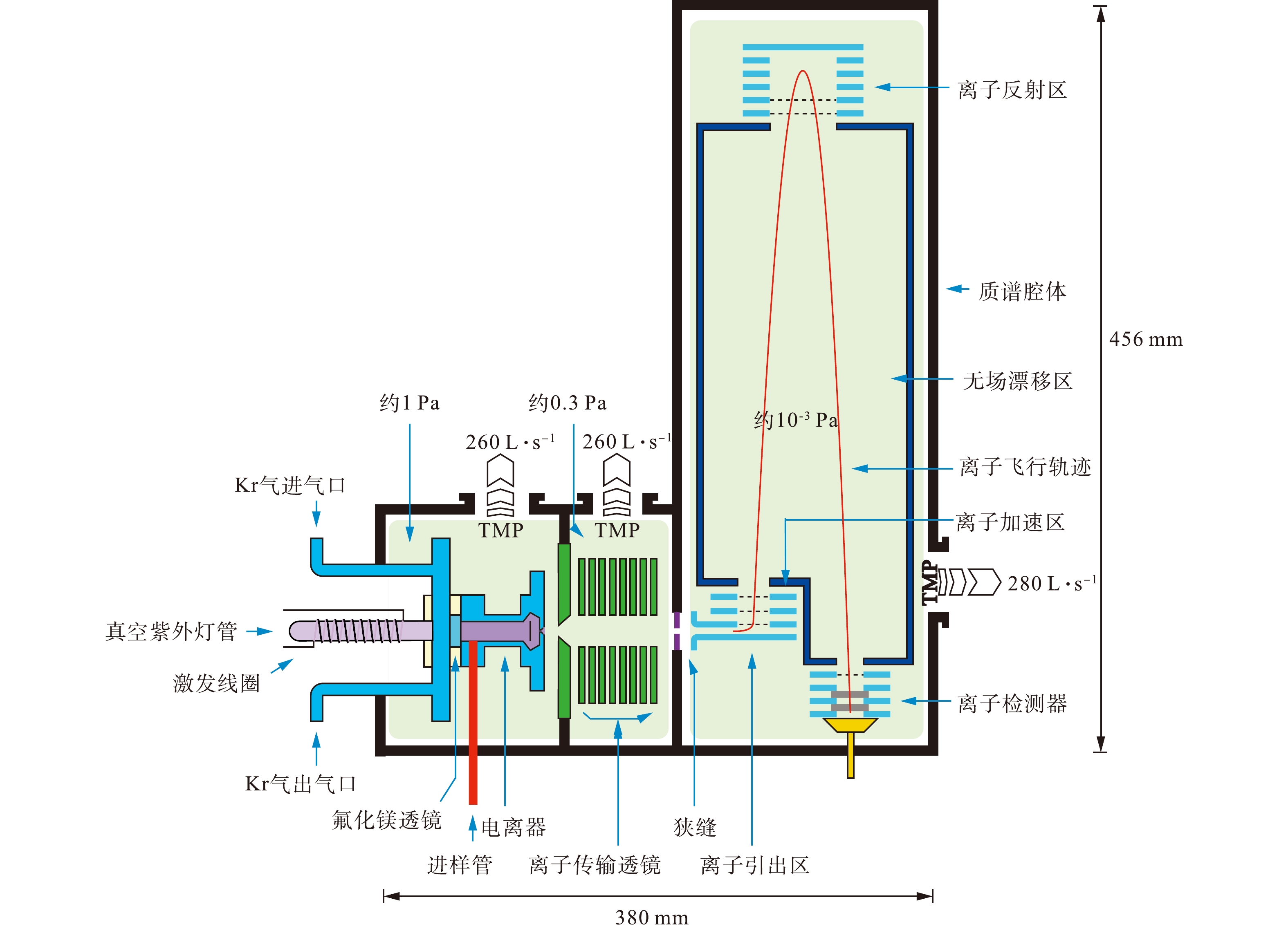
 下载:
下载:

